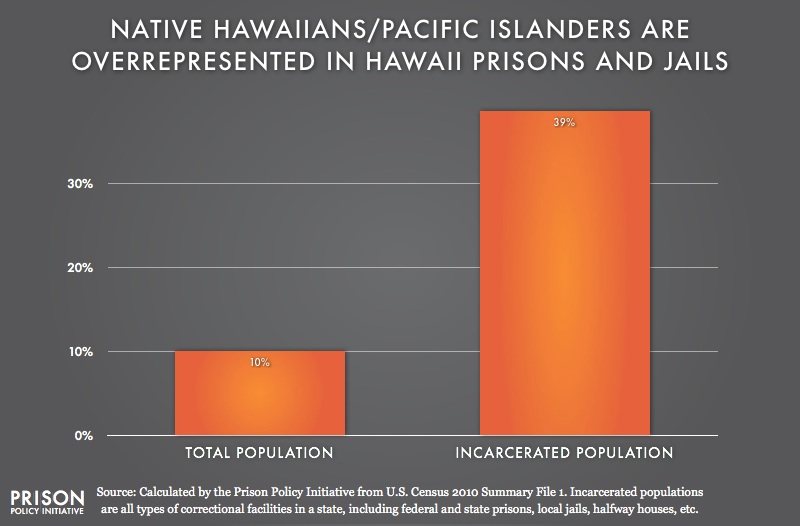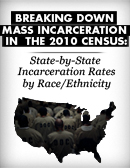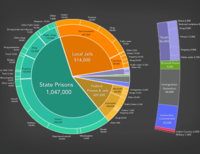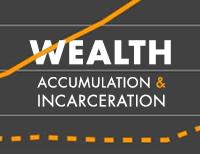
Data Source: U.S. Census 2010, Summary File 1. (Graph: Leah Sakala, May 2014)
 This graph is a part of Breaking Down Mass Incarceration in the 2010 Census: State-by-State Incarceration Rates by Race/Ethnicity, a Prison Policy Initiative briefing.
This graph is a part of Breaking Down Mass Incarceration in the 2010 Census: State-by-State Incarceration Rates by Race/Ethnicity, a Prison Policy Initiative briefing.
Data notes:
Several factors lead us to believe that our analysis understates the extent of the disproportionate incarceration of Hawaii's Native Hawaiians. The Department of Public Safety (which runs the prison and jail system) says that the state's incarcerated population is 39% Native Hawaiian or part Native Hawaiian. Some organizations and individuals who work in the correctional facilites report higher numbers. Can the Census data shed new light on how many Native Hawaiians Hawaii incarcerates?
We find three data points that suggest that the Native Hawaiian people are inaccurately reflected in a lot of reported demographic data from both the state and the U.S. Census Bureau:
It matters how race/ethnicity data is collected, by whom and for what purpose. Often, the data collected by the Census Bureau on the race and ethnicity of incarcerated populations comes directly from correctional facility administrators, and so it will be compromised by any methodological shortfalls in the original data collection. For example, a person who identifies as Native Hawaiian and participates in Native cultural programming might have been classified by the administration as white without that person ever having been asked to self-identify. This problem is particularly important in the Native Hawaiian context because many Native Hawaiians are of more than one race, but many correctional systems are still collecting data under the antiquated conception that people can be of only one race. On the other hand, sometimes the Census Bureau collects its data directly from incarcerated people and we can get a new piece of data to compare with the correctional facilities' data.
Data variations suggest that the Census Bureau relied on Hawaii Department of Public Safety records for the race and ethnicity of incarcerated people in the 2010 Census, but may have directly enumerated incarcerated people in the 2000 Census in at least some facilities, which then allowed at least some incarcerated people to select more than once race.
Allowing people to select more than one race makes a large difference in the case of Native Hawaiians. Using our detailed analysis of the Halawa Correctional Facility, we can see that the U.S. Census was clearly conducted differently at this facility in 2010 than in 2000 in a way that moved people of more than one race into single-race categories:
Native Hawaiian or other Pacific Islander alone Native Hawaiian and Other Pacific Islander in combination with other racial groups Native Hawaiian alone or in combination with other racial groups More than one race (of any kind) Halawa Correctional Facility, 2000 Census 24.5% 31.3% 55.8% 40.0% Halawa Correctional Facility, 2010 Census 43.6% 1.5% 45.1% 2.3% And, although the Census Bureau doesn't break down the demographics beyond "Native Hawaiian and other Pacific Islanders," Native Hawaiians are a vast majority (85%) of the Native Hawaiian and Other Pacific Islander population incarcerated by the department. (In 2008, the department reported that its population was 39% Hawaiian/Part Hawaiian, 5% Samoan, and 2% "Other Pacific Islander.")
Clearly, there were more people labeled "Native Hawaiian or Pacific Islander alone" at Halawa prison in 2010 than there were in 2000, but the dramatic difference in the number of people reported as being of more than one race raises many questions. As the data from the federal facility (in point #2 below) suggests, the answer is unlikely to be a massive change in the race of people sent to prison.
While the above comparison focuses on Halawa, we found other correctional facilities in the 2000 Census where we could determine (because the facility was the entirety of its block) the portion of the incarcerated population that was Native Hawaiian and Pacific Islander:
Facility Native Hawaiian/Pacific Islander or Native Hawaiian/Pacific Islander and other racial groups Halawa Correctional Facility 55.8% Waiawa Correctional Facility 52.8% Kauai Com Correct Center 42.7% Other researchers may find those figures useful.
- Properly counting people of more than one race is particularly important in Hawaii because so many Native Hawaiians are of more than one race. According to the U.S. Census Bureau, "Of all respondents who reported Native Hawaiian, 70 percent reported one or more other races and/or detailed NHPI groups." (Source: The Native Hawaiian and Other Pacific Islander Population: 2010, p. 17.)
While the population in correctional facilities could be very different than the national Native Hawaiian and Other Pacific Islander statistics, the 2010 U.S. Census counts of a federal facility in Hawaii suggest that the difference seen between 2000 and 2010 in the state correctional facilities was the result of data collection practices and not sudden changes in the racial makeup of the incarcerated people. (The Federal Detention Center Honolulu, is a federal detention center, but also holds some of the state's incarcerated population under contract with the Department of Public Safety.)
Native Hawaiian or other Pacific Islander alone Native Hawaiian and Other Pacific Islander in combination with other racial groups Native Hawaiian alone or in combination with other racial groups More than one race (of any kind) Federal Detention Center Honolulu, 2010 Census 21.0% 27.3% 48.3% 34.9%
The state Halawa prison reported almost no one of more than one race and the federal facility reported that 35% of the facility was of more than once race. This large difference is likely due to data collection differences rather than population differences. - A large portion of Hawaii's prison population is sent out-of-state, and that population is disproportionately Native Hawaiian. Because the Census Bureau counts people where they are confined, both the incarceration rate for Native Hawaiians and the portion of the prison population that is Native Hawaiian is underreported in these graphs. In 2010, Office Of Hawaiian Affairs released a report The Disparate Treatment of Native Hawaiians in the Criminal Justice System finding that Native Hawaiians were disproportionately sent to out-of-state prisons. The report said that in 2005, "of the people in out-of-state facilities, 41 percent are Native Hawaiians". The numbers may have gotten worse, as our our analysis of the Census Bureau data for Arizona's Saguaro Correctional Facility says that that facility is 48% Native Hawaiian alone, and 49% Native Hawaiian alone or in combination with other racial groups.
Events
- March 19, 2025:
Join Prison Policy Initiative’s Advocacy Department at 1 PM EST on Wednesday, March 19, 2025, for a webinar about understanding recidivism. We will cover strategies from our recidivism toolkit, including an overview of recidivism statistics and what they really mean, how to combat the “Willie Horton” effect, and ways that advocates can transform the narrative around reentry to make it less focused on negative outcomes and more focused on the ways that returning citizens contribute to their communities.
Not near you?
Invite us to your city, college or organization.



